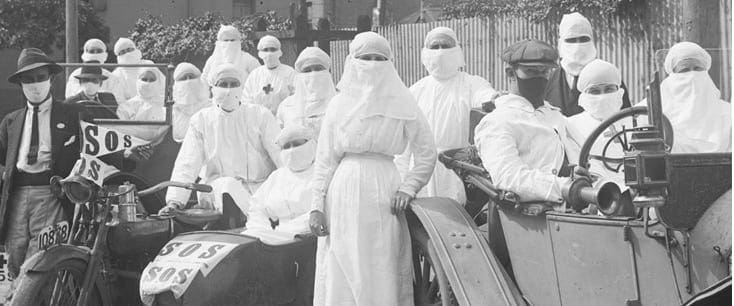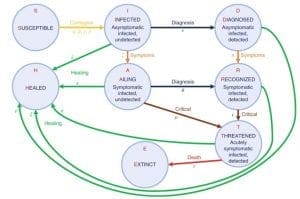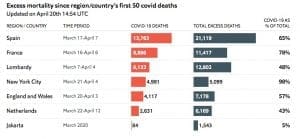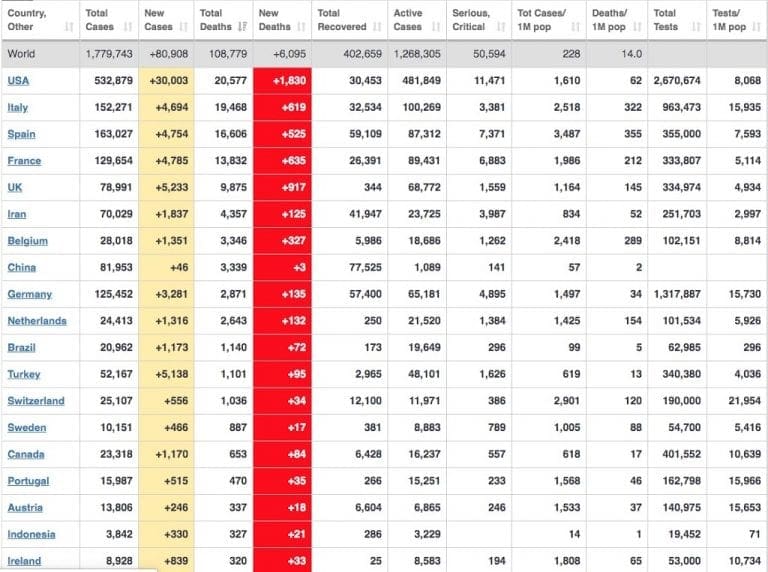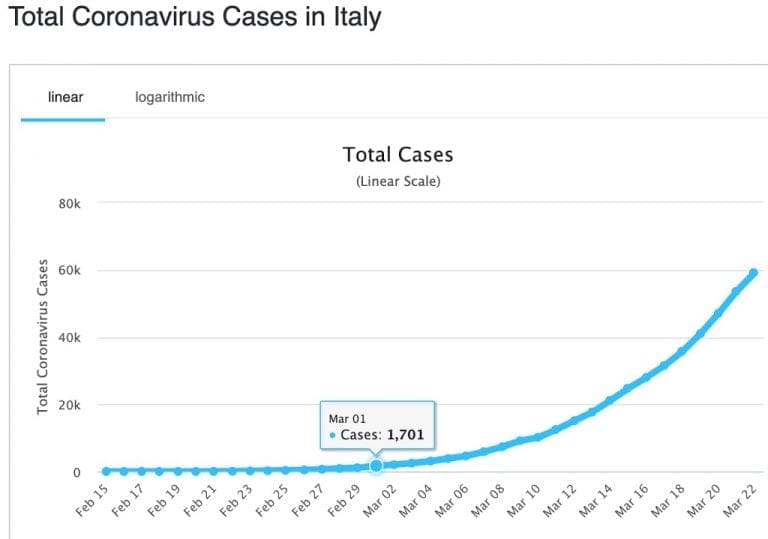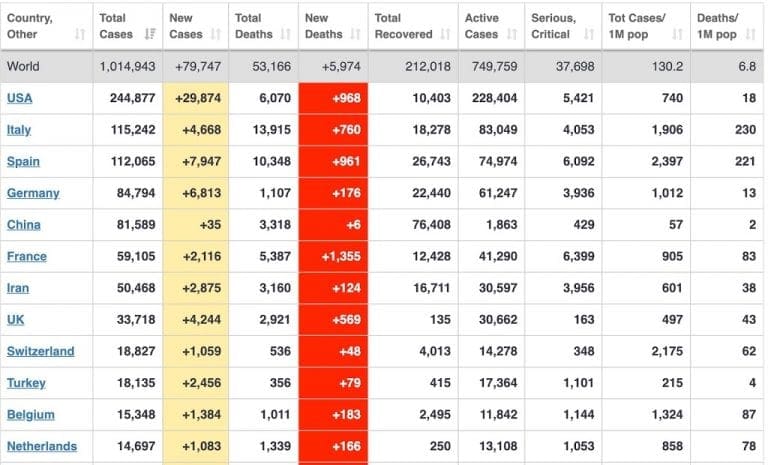COVID at end of April 2020
Looking at the COVID-19 data at the beginning of this week I can see a few things.
- Overall the data for the world is flattening (again) from its exponential climb. This is due to all countries at the top of the table (western countries: USA, France, Spain, Italy, Germany, UK, Belgium, Canada) achieving a good amount of flattening for both deaths and new cases. It is getting possible to predict number of deaths for each of these countries – provided there is no resurgence there.
- A few countries (Singapore, Sweden) that had been doing well are possibly now experiencing the virus getting out of control. Either a warning to us all or a media beat up. Singapore still has a trivial number of deaths.
- A few countries (Australia, NZ) are doing very well.
- Those 12 countries account for 81% of the reported deaths worldwide.
- In the US, the top 20% of the states (New York, New Jersey, Michigan, Massachusetts, Illinois, Connecticut, Pennsylvania, Louisiana, California, Florida) account for 80% of the deaths. Modelling is predicting that (if the other states do not ramp up – and there is no reason to assume they will not ramp up), the USA can expect 68,000 deaths (with a range out to 122,000).
- South America is now winding up.
- The rest of the undeveloped world has not yet joined in. It appears to have just begun in Africa which, country by country, will follow the same set of curves with little money, no equipment and few medical staff. Some countries might be better prepared from recent experience with frequent epidemics and Ebola.
- Most of what happens in Africa, India, South America will now be ignored. The media will shift attention away from covid and onto our continued diet of outrage.
- How to reopen after the shut down. Each country will, of course, make its own path – hopefully learning from its neighbours. Some countries (I’m especially thinking of the US) are going to rush into reopening and will see a resurgence. Mr Trump is still rabbiting on about reopening this week.
- Discussion about competition – ‘we did it better than them’. Expect data to be manipulated to show ‘we are best’ – either at handling the virus outbreak or reopening.
- Re-making the world. Political and social changes post-virus.
- Changes to education, shopping, socialising.
- Dealing with resurgence, maybe annual. Is COVID the new normal? If so, will we have more/annual shutdowns?
- Vaccines and treatments. Development of? testing of? the race for? who will own? who will profit? (The noises Trump is making is for the US to own the rights for vaccines and treatments.) Is it possible for medical research to have a breakthrough and find a useable set of anti-virals that we can trot out for any viral outbreak?
- A remaking of WHO – which probably needs it as its charter is old (1948) and was made for different times. The WHO has been extremely successful at its work until this pandemic. (Eradication of smallpox, near-eradication of polio, and development of an Ebola vaccine. Its current priorities include communicable diseases, particularly HIV/AIDS, Ebola, malaria and tuberculosis.) Now expectations don’t match its carter. I find interesting the clamour for the WHO to be allowed to enter and investigate a country without that country’s permission. Clamour from countries (eg USA) that would never allow that to happen to them.
- The hunt for patient zero and pinpointing the cause of the outbreak. Expect a lot of finger pointing especially as Trump ramps up his attacks on China. Note: we still have no idea where the Spanish Flu began (certainly not Spain) – many theories have been proposed but none are provable.
- Unemployment, possible food riots. The extent that the young have been forced to take a huge hit for the older rest of each country.
- An increase in mental illness from being locked inside for so long with a strong feeling of helplessness. If I recall correctly, much of the ‘shell shock’ of WW1 was due to ‘being under attack while unable to move or escape’. Sounds similar. Suicides will increase.
- Domestic and family violence has escalated during the shutdown.
- Extreme right is using the virus as a tool to expand its reach and consolidate its political position. Expect a rise of ‘the strongman’. (This rise has already been underway for about a decade.)
- China is doing a dreadful job of bragging about how well it has done in dealing with COVID-19. This has not gone down well in the west and certainly not in the US.
I think it interesting to compare medical practice to handle the virus outbreak in 1918-19 and the current COVID-19 outbreak. I look at photos of nurses and doctors in masks from 18-19 (above) and they look very similar to today (below).
We have come a long way with medical treatment in 100 years. Let us hope that this pandemic will lead to breakthroughs with respect to viruses and viral infection. For example, treatment for: cancer, autoimmune diseases, Parkinson’s, Smallpox, HIV, Dengue, rabies, influenza, chronic fatigue. That would be a great payback for the economic loss the world has suffered from the shutdown.
The highlight of the week for me has been Mr Trump suggestion that the virus can be treated with injections of disinfectant.
Trump is an important factor in the next few weeks/months. There is no doubt that he is a clever political strategist, completely self-absorbed, working for his own self-interest, needing to be the best, unable to accept any fault. With this combination, expect a lot of playing one side against the other, a lot of blaming and finger pointing. I’m certainly expecting that he will go all out against China, the WHO and any US State an attack on which he thinks will give him a political advantage. Historically, starting a war has been a great way for leaders in trouble to deflect attention away from them. Trump has performed extremely badly in handing this pandemic. He needs to deflect. I expect he will go after China and even be prepared to start a civil war in the US.
That was opinion and just shows my paranoia. The next is back to more my territory – data.
I did find an interesting paper attempting to mathematically model spread of contagion while using various estimates of R0 (the number of people that can be infected by one person). The ‘results demonstrate that restrictive social-distancing measures will need to be combined with widespread testing and contact tracing to end the ongoing COVID-19 pandemic’. They also show that ‘if the lockdown is weakened, a sudden and strong increase of the spread of disease, a prolonged emergency and more deaths‘.Very interesting findings. (Unless you are interested in Ordinary Differential Equations, there in no need to read beyond the heading ‘Methods’.)
Counting deaths. Economist published estimates of excess deaths – ie deaths in excess of the number expected for the month for various locations. The table below indicates the percentage deaths attributed to COVID vs Excess Deaths. Jakarta is managing to report just 5% of COVID deaths – and that corresponds very well with the reported increase in coffin making and burials.
- Dr Norman Swan on Coronacast – Australia centric but applicable worldwide.
- The Economist – UK centric but applicable worldwide. Lately the covid parts of their editions are free. I especially like their invited articles (such as this by Bill Gates)
- Useful data is published daily on https://www.worldometers.info/coronavirus/ now showing test for each country
- Modelling here may even be accurate. (It could be updated more often to be useful).
